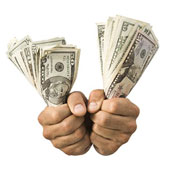 Recently Heath Albritton with F & M Bank and I were having a spirited conversation about the money supply, as a result, he forwarded me this interesting and straight forward narrative. It’s a little off my normal real estate topics, but I thought I would share.
Recently Heath Albritton with F & M Bank and I were having a spirited conversation about the money supply, as a result, he forwarded me this interesting and straight forward narrative. It’s a little off my normal real estate topics, but I thought I would share.
Money is an important factor in our lives, yet its origins remain a mystery to many people. Centuries ago, money arose as gold (hence the gold standard), whose owners would store their supply with a goldsmith. The goldsmith, in turn, would issue receipts for the stored gold. Because the receipts were easier to exchange than the physical gold, the receipts became the medium of exchange.
Today, these receipts are no longer tethered to gold. In fact, our currency is tethered to nothing. The money we have today is known as fiat money, in that it has no intrinsic value and realizes its money status by government decree.
When most people think of money, they think of the physical currency in circulation – the paper and coins manufactured at a mint. But physical currency is only a small percentage of the money in circulation. Most money is held in digital form, in checking and savings accounts and time deposits.
A fiat money supply is predicated on debt issuance. The Federal Reserve purchases assets, namely government bonds, on the open market from financial institutions. It then pays for these purchases by creating money ex nihilo (“out of nothing”) and depositing it with these institutions. In turn, the financial institutions create even more money by lending the money created by the Federal Reserve through fractional reserve banking. For example, if a bank has $1,000 on deposit and the Federal Reserve mandates a 10 percent reserve requirement, the bank is able to create an additional $9,000 in loans, which is essentially new money created from the $1,000 on deposit.
When the overall economy contracts, the overall money supply tends to contract as well, because people are less apt to borrow. To counteract the decrease in money supply – which can be substantial – the Federal Reserve will inject more money into the banking system through open-market operations, also known as “quantitative easing.” In short, as loan demand goes so goes the nation’s money supply.
Of course, if you have money, fiat or otherwise, let’s chat about acquiring real estate in Nashville. You’ll be glad that you did.


